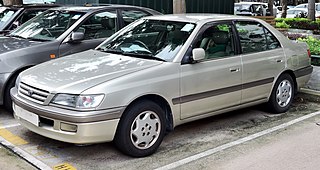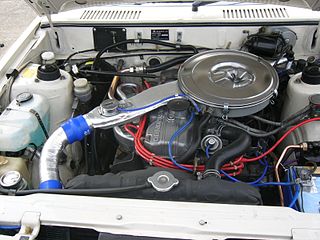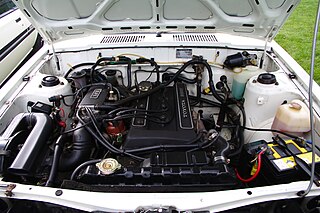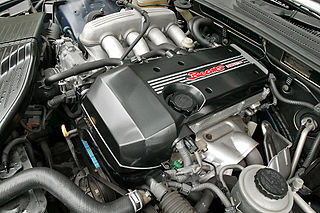
A hemispherical combustion chamber is a type of combustion chamber in a reciprocating internal combustion engine with a domed cylinder head notionally in the approximate shape of a hemisphere. An engine featuring this type of hemispherical chamber is known as a hemi engine.

The Ford CVH engine is a straight-four automobile engine produced by the Ford Motor Company. The engine's name is an acronym for either Compound Valve-angle Hemispherical or Canted Valve Hemispherical, where "Hemispherical" describes the shape of the combustion chamber. The CVH was introduced in 1980 in the third generation European Escort and in 1981 in the first generation North American Escort. Engines for North America were built in Ford's Dearborn Engine plant, while engines for Europe and the UK were built in Ford's then-new Bridgend Engine plant in Wales.

The LA engines are a family of pushrod OHV small block 90° V-configured gasoline engines built by Chrysler Corporation. It was factory-installed in passenger vehicles, trucks and vans, commercial vehicles, marine and industrial applications from 1964 through 1991 (318) & 1992 (360). The combustion chambers are wedge-shaped, rather than the polyspherical combustion chambers in the predecessor A engine or the hemispherical combustion chambers in the Chrysler Hemi engine. LA engines have the same 4.46 in (113 mm) bore spacing as the A engines. LA engines were made at Chrysler's Mound Road Engine plant in Detroit, Michigan, as well as plants in Canada and Mexico. The "LA" stands for "Light A", as the 1956 - 1967 "A" engine it was closely based on and shares many parts with was nearly 50 pounds heavier. The "LA" and "A" production overlapped from 1964 - 1966 in the US and through 1967 in export vehicles when the "A" 318 engine was phased out. Willem Weertman, who later became Chief Engineer – Engine Design and Development, was in charge of the conversion. The basic design of the LA engine would go unchanged through the development of the "Magnum" upgrade (1992-1993) and into the 2000s with changes to enhance power and efficiency.

The Chrysler Hemi-6 engine is a family of inline six-cylinder petrol engines produced by Chrysler Australia in three piston displacements and multiple configurations. Hemi-6 engines were installed in Australian-market Chrysler Valiants from 1970 through 1981. It was also installed in the Valiants closely related variants, the Chrysler VIP, the Chrysler by Chrysler & the Valiant Charger.

The Toyota A Series engines are a family of inline-four internal combustion engines with displacement from 1.3 L to 1.8 L produced by Toyota Motor Corporation. The series has cast iron engine blocks and aluminum cylinder heads. To make the engine as short as possible, the cylinders are siamesed.

The Toyota Corona is an automobile manufactured by the Japanese automaker Toyota across eleven generations between 1957 and 2001. On launch, the Corona was Toyota's next to highest product in their range, just below the Crown. The Corona was marketed in the JDM at Toyota's Toyopet Store dealership channels, and the Corona was one of Toyota's first models exported to other global markets, followed by the smaller Toyota Corolla.

Toyota Motor Corporation's M family of engines were a longitudinally mounted straight-6 engine design. They were used from the 1960s through the 1990s. All M family engines were OHC designs. While the M family was born with a chain-driven single camshaft it evolved into a belt drive DOHC system after 1980. All M family engines used a cast-iron block with an aluminum cylinder head, and were built at the Toyota Kamigo plant in Toyota City, Japan.

The Toyota Century is a limousine produced mainly for the Japanese market, serving as Toyota's flagship car within Japan; globally the unrelated Lexus LS series is Toyota's flagship luxury model. Production of the Century began in 1967, and the model received only minor changes until redesigns in 1997 and 2018.

The Mitsubishi Astron or 4G5/4D5 engine, is a series of straight-four internal combustion engines first built by Mitsubishi Motors in 1972. Engine displacement ranged from 1.8 to 2.6 litres, making it one of the largest four-cylinder engines of its time.

The Toyota JZ engine family is a series of inline-6 automobile engines produced by Toyota Motor Corporation. As a replacement for the M-series inline-6 engines, the JZ engines were 24-valve DOHC engines in 2.5- and 3.0-litre versions.

The Toyota R family was a series of inline-four gasoline automobile engines. Designed for longitudinal placement in such vehicles as the Celica and Hilux and in production from 1953 through 1997, usage faded out as many of Toyota's mainstream models moved to front-wheel drive. Overhead cam (OHC) versions featured a chain-driven camshaft.

The Toyota T series is a family of inline-4 automobile engines manufactured by Toyota beginning in 1970 and ending in 1985. It started as a pushrod overhead valve (OHV) design and later performance oriented twin cam (DOHC) variants were added to the lineup. Toyota had built its solid reputation on the reliability of these engines.

The Toyota Motor Corporation G-family engine is a family of straight-6 piston engines produced from 1979 to 2008. It is notable in that only a single displacement, 2.0 L (1,988 cc), was produced in this series. Initially belt-driven OHC non-interference engines, multivalve DOHC and variable valve timing were added later during the production run. The 1G-GEU was Toyota's first mass produced four-valve twincam engine. A prototype version of the 1G-GEU called the LASREα–X, featuring twin-turbos, variable valve timing and intake as well as variable displacement, was fitted to the Toyota FX-1 show car at the 1983 Tokyo Motor Show. It showcased a number of technologies which were later to become commonplace.

The Toyota Mark II is a compact, later mid-size sedan manufactured and marketed in Japan by Toyota between 1968 and 2004. Prior to 1972, the model was marketed as the Toyota Corona Mark II. In some export markets, Toyota marketed the vehicle as the Toyota Cressida between 1976 and 1992 across four generations. Toyota replaced the rear-wheel-drive Cressida in North America with the front-wheel-drive Avalon. Every Mark II and Cressida was manufactured at the Motomachi plant at Toyota, Aichi, Japan from September 1968 to October 1993, and later at Toyota Motor Kyushu's Miyata plant from December 1992 to October 2000, with some models also assembled in Jakarta, Indonesia as the Cressida.

The Chrysler Hemi engines, known by the trademark Hemi, are a series of American V8 gasoline engines built by Chrysler with overhead valve hemispherical combustion chambers. Three different types of Hemi engines have been built by Chrysler for automobiles: the first from 1951 to 1958, the second from 1964 to 1971, and the third beginning in 2003. Although Chrysler is most identified with the use of "Hemi" as a marketing term, many other auto manufacturers have incorporated similar designs. The engine block and cylinder heads were cast and manufactured at Indianapolis Foundry.

The Toyota S Series engines are a family of straight-4 petrol or CNG engines with displacement from 1.8 L to 2.2 L produced by Toyota Motor Corporation from January 1980 to August 2007. The series has cast iron engine blocks and alloy cylinder heads.

The Toyota Crown is an automobile which has been produced by Toyota in Japan since 1955. It is primarily a line of mid-size luxury cars that is marketed as an upmarket offering in the Toyota lineup.

The intake/inlet over exhaust, or "IOE" engine, known in the US as F-head, is a four-stroke internal combustion engine whose valvetrain comprises OHV inlet valves within the cylinder head and exhaust side-valves within the engine block.
The Toyota F series engine was a series of OHV inline-6-cylinder engines produced by Toyota between November 1949 and 1992. They are known for their high amount of torque at low engine speeds, massive cast-iron blocks and heads and also their high reliability. The F engine had one of the longest production runs of any Toyota engine. The F engines all incorporate overhead valves actuated by pushrods from a gear driven camshaft in the lower portion of the engine.
The ball-stud hemi was an automobile engine designed by Chrysler Corporation in the late 1960s. It never entered production.

















